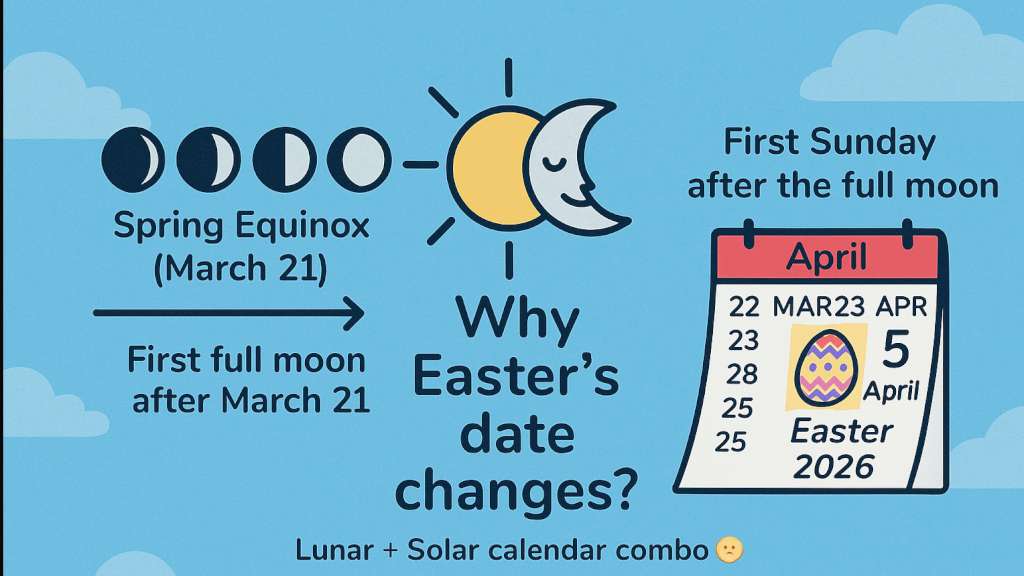When’s Easter 2026? Let’s Settle This Once and For All (And Why It’s Never Simple).
So you’re trying to plan your 2026 spring brunch or dodge family Zoom calls, and suddenly realize: Wait, when exactly is Easter next year? Trust me, I’ve been there. Last year, I accidentally scheduled a LAN party on Palm Sunday and got roasted by my aunt via group text. Lesson learned: Easter’s a moving target. Here’s the lowdown for 2026—and why this holiday refuses to sit still on our calendars.
First off, mark April 5, 2026 in pastel-colored Sharpie. That’s the Sunday when most of us will be hunting for eggs or pretending to like marshmallow Peeps. But why that date? Blame the moon, ancient church councils, and a dash of astronomical drama.
Here’s how it works: Western Christianity (think Catholics, Protestants) uses a formula older than your grandma’s fruitcake recipe. Back in A.D. 325, some very serious bishops decided Easter should fall on the first Sunday after the first full moon following the spring equinox. The equinox? They fixed that to March 20/21, even though the actual astronomical event might wiggle by a day. It’s like setting your clock to “close enough” and calling it a win.
In 2026, the spring equinox lands on March 20. The next full moon? April 2. First Sunday after that? April 5. Easy, right? Not so fast. The Orthodox Church still uses the Julian calendar for their calculations, which usually pushes their Easter weeks later. But here’s the plot twist: In 2026, both East and West sync up! It’s like seeing two rival streaming services drop their best shows on the same day—rare, chaotic, and weirdly satisfying for history nerds.
Now, why hasn’t anyone fixed this messy system? Trust me, they’ve tried. Some folks want Easter permanently parked on, say, the second Sunday in April. But good luck convincing churches to ditch a 1,700-year-old tradition. My take? The chaos is half the fun. Last March, I watched my buddy Dave nearly short-circuit his smart fridge trying to program Easter alerts for his kids. “It’s supposed to be resurrection, not calculus!” he groaned.
Fun fact: This lunar dance means Easter can swing anywhere from March 22 to April 25. Try explaining that to your calendar app. And if you’re road-tripping that weekend, double-check local traditions. Some states go full parade mode; others treat it like a Target clearance sale. Either way, April 5’s your golden ticket to pastel everything. Just don’t blame me if your cousin’s “organic free-range egg hunt” turns into a Hunger Games reenactment.
Short answer: The moon’s trolling us. Long answer: Easter’s tied to both solar and lunar cycles, like a celestial game of Twister. Early Christians wanted Easter to align with Passover (which follows the moon), while also nodding to spring’s rebirth vibes. The result? A holiday that slides around like socks on a hardwood floor.
Imagine this: You’re a 4th-century bishop. Your job? Unite churches across time zones without WiFi. Your solution: Anchor Easter to the first full moon after the equinox. Genius? Maybe. Confusing for future Costco planners? Absolutely.
Here’s the deal: Easter’s timing is tied to both the moon and the sun. Yep, it’s a cosmic combo! Let me break it down:
Easter 2026 celebrates Jesus’ resurrection in Christianity. Early church leaders wanted it linked to Passover, a Jewish holiday based on lunar cycles (specifically the first full moon of spring). So, in 325 CE, they set a rule: Easter falls on the first Sunday after the first full moon following the spring equinox (March 21).
Spring equinox → next full moon → next Sunday. That’s why Easter hops around between March 22 and April 25 every year.
Fixed holidays like Christmas (Dec 25) don’t dance with the moon. Even Islamic holidays shift yearly, but that’s because they follow a purely lunar calendar. Easter 2026? It’s a hybrid! Fun fact: Orthodox Christians sometimes celebrate it later because they use the older Julian calendar for calculations. So, thanks to the moon’s dance, Easter keeps us on our toes!
Think of the spring equinox as Easter’s starting pistol. For Western churches, it’s always March 20/21—even if astronomers side-eye them. Next comes the “Paschal Full Moon” (a calculated moon, not always the real one), then boom: Next Sunday = Easter.
But here’s where it gets spicy: Orthodox Christians use the Julian calendar’s equinox date, which drifts later over time. Most years, their Easter lags weeks behind—but in 2026, the stars align (literally). It’s like when your Steam wishlist games all go on sale simultaneously. A miracle, really.
So there you go. April 5, 2026: Save the date, dodge the Peeps, and maybe send a thank-you card to the moon.
Alright, let’s crack this! For Western Christians, Easter’s date boils down to three things: the spring equinox, the moon, and a 1,700-year-old rule. Here’s the scoop:
The spring equinox (around March 21) is Earth’s “balance day”—when sunlight splits evenly between the hemispheres. Back in 325 CE, church leaders decided: Easter must happen on the first Sunday after the first full moon following this equinox.
So, step by step:
March 21 → Mark the equinox.
Next full moon → Wait for it (even if it’s just a day later!).
First Sunday after that moon → Boom, Easter 2026!
This combo locks Easter between March 22 and April 25. For example:
If the full moon is March 22, Easter could be March 23 (if it’s a Sunday).
If the full moon is April 18, Easter slides to April 20 (next Sunday).
But wait—there’s a twist! Orthodox Christians use the older Julian calendar for calculations, so their equinox “date” and full moon timings can differ. That’s why Eastern and Western Easter sometimes miss each other by weeks.
TL;DR: Blame the moon, the sun, and ancient church math!

